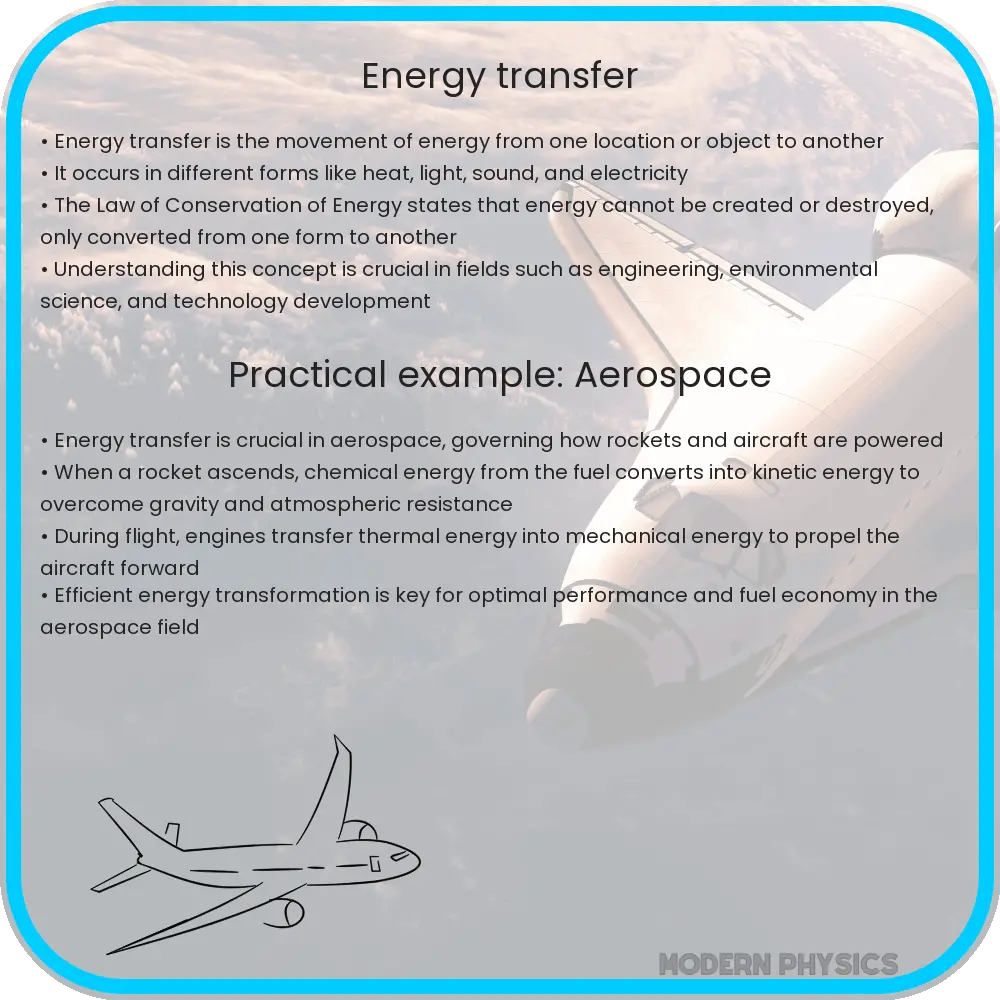Explore the essentials of energy transfer in dynamics, covering efficiency, methods, and systems, and their impact on technology and sustainability.

Understanding Energy Transfer in Dynamics
Energy transfer is a fundamental concept in the field of dynamics, pivotal to understanding how energy moves and changes form within different systems. It encompasses a wide array of applications, from simple mechanical systems to complex biological processes and technological applications. This article explores the efficiency, methods, and systems involved in energy transfer, providing a comprehensive overview of its role in dynamics.
Efficiency of Energy Transfer
The efficiency of energy transfer refers to how effectively energy is converted from one form to another without significant loss. In physics, this concept is crucial when analyzing machines and systems where energy conservation is vital. For instance, in a simple pendulum, energy constantly shifts between kinetic and potential forms. The efficiency is determined by the amount of energy lost to friction or air resistance compared to the energy put into the system. In more complex systems, like internal combustion engines, efficiency involves a myriad of factors including heat loss, mechanical friction, and the thermodynamic limits described by the Carnot efficiency.
Methods of Energy Transfer
- Conduction: This method involves the transfer of energy through a medium, such as a solid. In metals, for example, heat is transferred through the vibration of atoms and the movement of electrons.
- Convection: Convection occurs in fluids (liquids and gases) where warmer parts of the fluid rise and cooler parts sink, creating a cycle that transfers heat.
- Radiation: Energy transfer through radiation does not require a medium. It is the emission or absorption of energy in the form of electromagnetic waves, like sunlight.
Energy Transfer Systems
Diverse systems utilize these methods of energy transfer. In ecosystems, energy transfer is a key component, with sunlight being the primary energy source, converted through photosynthesis and then passed through various trophic levels. In mechanical systems, like engines, energy transfer involves converting chemical energy into mechanical work. In electrical systems, the conversion of mechanical energy into electrical energy, and vice versa, is a prime example of energy transfer dynamics. Renewable energy systems, like solar panels and wind turbines, also illustrate the complex interplay of energy transfer methods and efficiency.
Each system’s effectiveness is measured by its ability to minimize energy loss and maximize the intended energy transfer. Innovations in technology continuously seek to improve these efficiencies, addressing global challenges like sustainable energy and resource management.
Understanding the dynamics of energy transfer is not just academic; it’s a vital component of advancing our technological capabilities and developing sustainable solutions for the future.
Advanced Concepts in Energy Transfer
In exploring energy transfer in dynamics, it’s crucial to delve into more advanced concepts like entropy and the laws of thermodynamics. Entropy, a measure of disorder in a system, invariably increases in energy transfer processes, impacting efficiency. The laws of thermodynamics, particularly the first and second laws, govern the principles of energy conservation and entropy, providing a fundamental framework for understanding energy transformations in any system.
Energy Transfer in Renewable Resources
Renewable energy sources, such as solar, wind, and hydroelectric power, have become increasingly significant. These systems convert natural energy forms, like sunlight or wind, into electrical energy with varying degrees of efficiency. Solar panels, for example, convert sunlight into electrical energy through photovoltaic cells. Wind turbines transform kinetic energy from wind into mechanical energy and, subsequently, into electrical energy.
Technological Advancements and Future Prospects
Technological advancements continue to revolutionize the efficiency and methods of energy transfer. Innovations in materials science, for example, have led to more efficient photovoltaic cells and better thermal insulation materials. Emerging fields like nanotechnology and quantum physics promise further breakthroughs in energy transfer processes, potentially revolutionizing industries and leading to more sustainable energy practices.
Conclusion
Energy transfer in dynamics is a multifaceted field with profound implications for technology, the environment, and society. The efficiency of energy transfer systems directly impacts our resource consumption and environmental footprint. Understanding and improving these systems is crucial for advancing towards a sustainable future. Whether it’s the intricate energy transfer in biological systems, the conversion of chemical energy to mechanical work in engines, or the harnessing of renewable resources, the principles of energy transfer lie at the heart of countless processes that drive our world. As we continue to innovate and develop new technologies, the study of energy transfer will remain a cornerstone of scientific and engineering endeavors, guiding us towards more efficient, sustainable, and environmentally friendly solutions.
